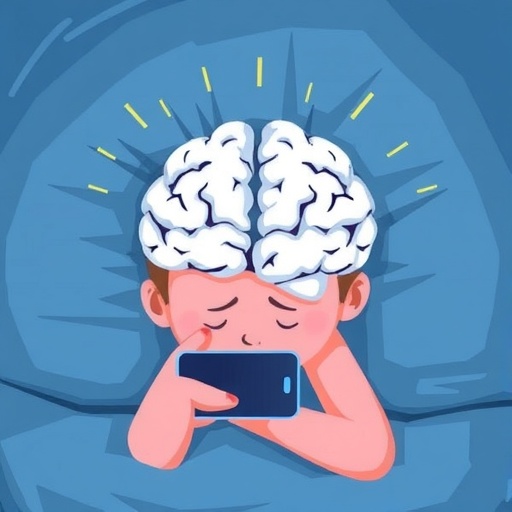In the rapidly evolving landscape of childhood development and mental health, a compelling new study published in JAMA Pediatrics sheds light on the complex relationship between screen time, sleep patterns, brain structure, and depressive symptoms during the critical stages of late childhood and early adolescence. This research, conducted by a multidisciplinary team, reveals that increased screen exposure in late childhood correlates with heightened depressive symptoms, potentially mediated by disruptions in sleep duration and alterations in white matter organization within the developing brain.
The foundation of this study lies in the growing concern over the pervasive presence of digital devices in children’s daily lives. As screen time escalates, health professionals and researchers alike have speculated about its potential ramifications not only on psychological well-being but also on neurodevelopmental processes. This investigation provides some of the first robust data elucidating how excessive screen exposure may intertwine with neurobiological changes during a sensitive developmental window.
Central to the findings is the role of sleep as a vital intermediary affected by screen use. The study corroborates the hypothesis that increased screen time contributes to shorter sleep durations in late childhood. Given that sleep is fundamental to cognitive and emotional regulation, truncated sleep periods during this phase can detrimentally affect mood and psychological resilience. These disruptions in restorative sleep patterns appear to be closely linked to the emergence of depressive symptoms among children transitioning into adolescence.
Beyond sleep, the study intriguingly highlights alterations in white matter—the bundles of myelinated nerve fibers facilitating communication between different brain regions. White matter integrity is crucial for efficient neural connectivity and cognitive functioning. Using advanced neuroimaging techniques, the researchers identified that children with higher screen time exhibited worse white matter organization in early adolescence. Such neurostructural changes may reflect disruptions in neural maturation processes that underpin emotional regulation capacities.
These neurobiological insights are critical because they suggest that the relationship between screen use and depression is not solely behavioral but anchored in tangible, measurable brain changes. The findings point toward a mechanistic pathway in which excessive screen exposure compromises sleep quality and quantity, which in turn may contribute to white matter abnormalities, cumulatively increasing vulnerability to depressive symptoms.
The implications of this work extend beyond academic inquiry, stirring a crucial dialogue about public health, pediatrics, and neuroscience. In an age where digital devices are integral to social interaction, education, and entertainment, parents, clinicians, and policymakers must grapple with balancing technology use while safeguarding neurodevelopmental health. This study underscores the importance of implementing guidelines that promote healthy screen time limits alongside strategies to ensure adequate sleep.
From a methodological perspective, the study employed a longitudinal design capturing data across late childhood into early adolescence. This temporal approach adds strength to the observed associations, giving credence to the argument for causal pathways rather than mere correlations. Utilizing sophisticated neuroimaging modalities enabled the team to assess white matter microstructure with precision, advancing understanding of how environmental factors like screen exposure may physically sculpt the developing brain.
Moreover, the research aligns with and extends existing literature documenting the adverse consequences of sleep deprivation on emotional and cognitive outcomes. It integrates the dimensions of digital media consumption and brain development, bridging neuroscience with behavioral science in innovative ways. These interdisciplinary insights pave the way for future research investigating potential interventions targeted at modulating screen habits and improving sleep hygiene as preventive measures.
Importantly, the study acknowledges that not all screen time is equivalent—variability in content type, engagement level, and usage patterns may differentially impact outcomes. However, the broad observation remains that excessive screen exposure in late childhood is worrisome regarding its downstream effects on sleep, brain architecture, and mental health. This nuanced understanding invites refinement of digital media guidelines tailored for age-appropriate cognitive and emotional development.
In conclusion, this groundbreaking study published in JAMA Pediatrics offers compelling evidence linking elevated screen time in late childhood to increased depressive symptoms during early adolescence, mediated by disrupted sleep and compromised white matter integrity. The research carries pivotal implications for how we approach digital media exposure in young populations. It challenges caregivers and health professionals to prioritize not only the quantity but also the quality of children’s digital experiences while fostering optimal sleep practices.
As society moves deeper into digital integration, the stakes for ensuring healthy neurodevelopmental trajectories escalate. This research underscores the vital need for comprehensive strategies that harmonize technological advancement with child health imperatives. Supporting balanced screen time along with sufficient and restorative sleep emerges as a cornerstone for safeguarding mental health in developing minds. Future directions may explore intervention frameworks harnessing technology’s benefits while mitigating risks illuminated in this study.
Subject of Research: The associations among screen time, sleep deprivation, white matter brain structure, and depressive symptoms in late childhood and early adolescence.
Article Title: Not specified.
News Publication Date: Not specified.
Web References: Not provided.
References: (doi:10.1001/jamapediatrics.2025.1718)
Image Credits: Not provided.
Keywords: Sleep, Sleep deprivation, Depression, Pediatrics, Children, Adolescents, White matter, Social media, Television, Human health




